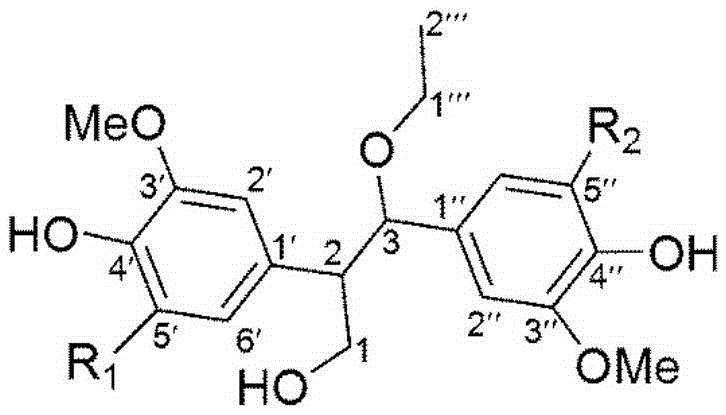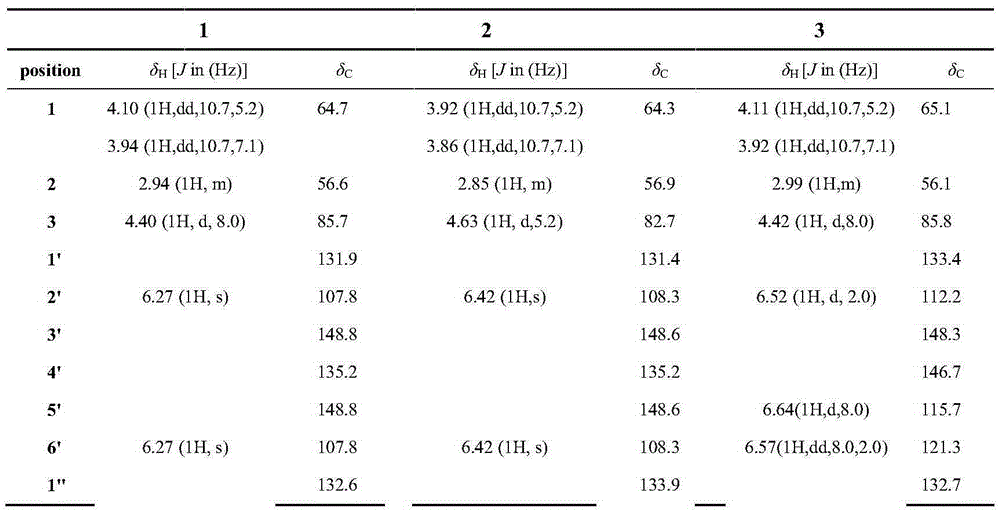Uses of aryl-substituted phenylpropanoid-based compounds in preparation of anti-complement drugs
A compound, phenylpropanoid technology, applied in the field of aryl-substituted phenylpropanoid compounds to prepare anti-complement drugs, which can solve problems such as excessive activation of the autoimmune system
- Summary
- Abstract
- Description
- Claims
- Application Information
AI Technical Summary
Problems solved by technology
Method used
Image
Examples
Embodiment 1
[0032] Embodiment 1. Preparation of phenylpropanoid compounds
[0033]Take 19 kg of root plum, heat and reflux with 95% ethanol to extract 3 times, suspend the extract with water after concentration, and extract with petroleum ether, ethyl acetate, and n-butanol respectively to obtain 135 g of ethyl acetate in the active part, and take 120 g of the extract to dry The method was applied to silica gel column chromatography, eluted with dichloromethane-methanol gradient (100:1→1:1), and the Fr.3 fraction eluted with dichloromethane-methanol (25:1) was reversed by ODS Column methanol / water (20% → 100%) for gradient elution, ultraviolet 210nm as the detection wavelength, a total of Fr.3 (1-8) fractions, Fr.3.4 and dichloromethane-methanol (20:1) Silica gel column chromatography and Sephadex LH-20 were carried out isocratically to separate, and finally HPLC was used to prepare the liquid phase for purification, and acetonitrile / water (32%) was used as the preparation condition to ob...
Embodiment 2
[0036] Example 2. Anti-complement classical pathway test in vitro
[0037] Take 0.1ml of complement (guinea pig serum), add barbiturate buffer solution (BBS) to prepare a 1:10 solution, and double-dilute with BBS to 1:20, 1:40, 1:80, 1:160, 1:10 320, 1:640 and 1:1280 solutions; take 1:1000 hemolysin, each concentration of complement and 2% sheep red blood cell (SRBC) each 0.1ml dissolved in 0.3ml BBS, mix well, put in 37℃ water bath for 30min Centrifuge at 5000rpm and 4°C for 10min in a low-temperature high-speed centrifuge; take 0.2ml of the supernatant from each tube and put it in a 96-well plate, and measure its absorbance at 405nm; set up a full hemolysis group (0.1ml 2% SRBC dissolved in 0.5ml Triple-distilled water), using the absorbance of triple-distilled water lysed blood vessels as the standard of total hemolysis, calculate the hemolysis rate, take the dilution of complement as the X-axis, and the percentage of hemolysis as the Y-axis to draw a graph, and select the ...
Embodiment 3
[0038] Example 3. Anti-complement alternative pathway test in vitro
[0039] Take 0.2ml of complement (human serum), add AP diluent (barbital buffer, pH=7.4, containing 5mMMg 2+ , 8mM EGTA) to prepare a 1:1 solution, and double-dilute it into a 1:2, 1:4, 1:8, 1:16, 1:32, 1:64 and 1:128 solution; take each concentration of complement 0.15ml, 0.15ml of AP diluent and 0.20ml of 0.5% rabbit red blood cells (RE), mix well, put in a low-temperature high-speed centrifuge at 37°C for 30 minutes, and centrifuge at 5000rpm and 4°C for 10 minutes; take the supernatant of each tube separately 0.2ml was placed in a 96-well plate, and the absorbance was measured at 405nm. At the same time, a complete hemolysis group (0.20ml 0.5% RE dissolved in 0.3ml triple-distilled water) was set up in the experiment. The complement dilution is plotted on the X-axis, and the percentage of hemolysis is plotted on the Y-axis. The lowest complement concentration that achieves a similarly high hemolysis rate...
PUM
 Login to View More
Login to View More Abstract
Description
Claims
Application Information
 Login to View More
Login to View More - R&D
- Intellectual Property
- Life Sciences
- Materials
- Tech Scout
- Unparalleled Data Quality
- Higher Quality Content
- 60% Fewer Hallucinations
Browse by: Latest US Patents, China's latest patents, Technical Efficacy Thesaurus, Application Domain, Technology Topic, Popular Technical Reports.
© 2025 PatSnap. All rights reserved.Legal|Privacy policy|Modern Slavery Act Transparency Statement|Sitemap|About US| Contact US: help@patsnap.com



